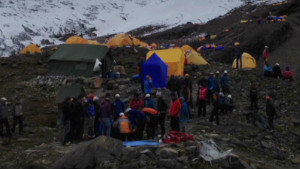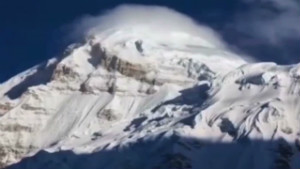Avalanche disaster revives fears about Nepal's crowded mountains
September 24, 2012 -- Updated 0901 GMT (1701 HKT)

Extreme skiers Glen Plake, left, and Greg Costa, in their tent on Nepal's Mount Manaslu
STORY HIGHLIGHTS
- Avalanche kills 8 on Nepal's Mount Manaslu
- Natural disaster revives concerns about crowding on Himalayan peaks
- Mount Everest saw 'traffic jams" in May this year
- Big peaks attracting more inexperienced climbers
But with Mount Manaslu
playing host to some 231 mountaineers from 25 teams this season -- an
unusually large number for the world's eighth largest peak -- the
natural disaster is likely to revive concerns about whether the
Himalayan mountains favored by commercial expeditions are becoming too
crowded.
The avalanche was
triggered by a huge piece of ice that fell from a glacier. It destroyed
some 25 tents at one camp and survivors spoke of being swept hundreds of
meters down the mountainside.
 Avalanche strikes climbers in Nepal
Avalanche strikes climbers in Nepal
 Conquering the world's highest peak
Conquering the world's highest peak
Manaslu had proved
particularly popular this year after Chinese authorities restricted
tourist visas, making access to Cho Oyu or Shishapangma, two 8,000m
(26,000 ft) peaks on the border with Tibet, difficult, said Grayson
Schaffer, senior editor at Outside magazine.
"The devastation of the avalanche was certainly magnified by the number of people that were in its way," he told CNN.
Ang Tscherting Sherpa,
the former head of the Nepal Mountaineering Association, said that
avalanches on this scale were relatively rare on Manaslu, which was
regarded as one of the easier 8,000m peaks to surmount.
He said the accident was not connected to the number of climbers.
"Such avalanches are hard to predict. It all depends on the snow fall and how warm the ground is."
The problem of
over-crowding is most stark at Mount Everest, the world's highest peak,
which attracts hundreds of climbers each year eager to take a shot at
the 8,848m (29,029 ft) summit.
In May this year,
climbers spoke of "traffic jams" as more than 150 climbers waited their
turn to summit the mountain during a window of good weather.
The consequences were
deadly as some climbers' air supplies began to run out and frost bite
began to set in. Six climbers died in the space of two days.
Leanne Shuttleworth, a
British woman who made a successful summit on May 20, said there were
bodies attached to fixed lines and she had to walk around them.
"There was a couple who were still alive," she told Britain's Daily Mail.
"Our Sherpa helped one of the people but a couple were so far gone they
didn't even know we were there. It was the most horrendous thing to
see."
A total of 10 climbers died on Everest in April and May, making it the third deadliest spring season on record after 12 people perished in 1996 and 11 in 2006.
Schaffer, who spent
April and May at Everest base camp, attributes the high death toll to
thrill-seeking amateurs, who are actively courted by cut-price
outfitters.
"If you really want to
climb one of these mountains, you can pay someone to take you regardless
of your experience level," he said. "In the past 10 years, it's gone
from almost unheard of to happening more often."
Nepal has eight of the 14 highest peaks in the world and tourism is a big earner for the landlocked country's economy.
September marks the beginning of the fall climbing season, which runs through November.
Unlike the spring
season, which comes after a dry winter, the fall season follows the wet
monsoon, coating the mountains in a lot more snow.
This attracts
mountaineer skiers like Glen Plake, who survived Sunday's avalanche. The
extreme sports celebrity had planned to ski down the mountain without
the aid of oxygen.
Manesh Shrestha in Nepal contributed to this report

ไม่มีความคิดเห็น:
แสดงความคิดเห็น